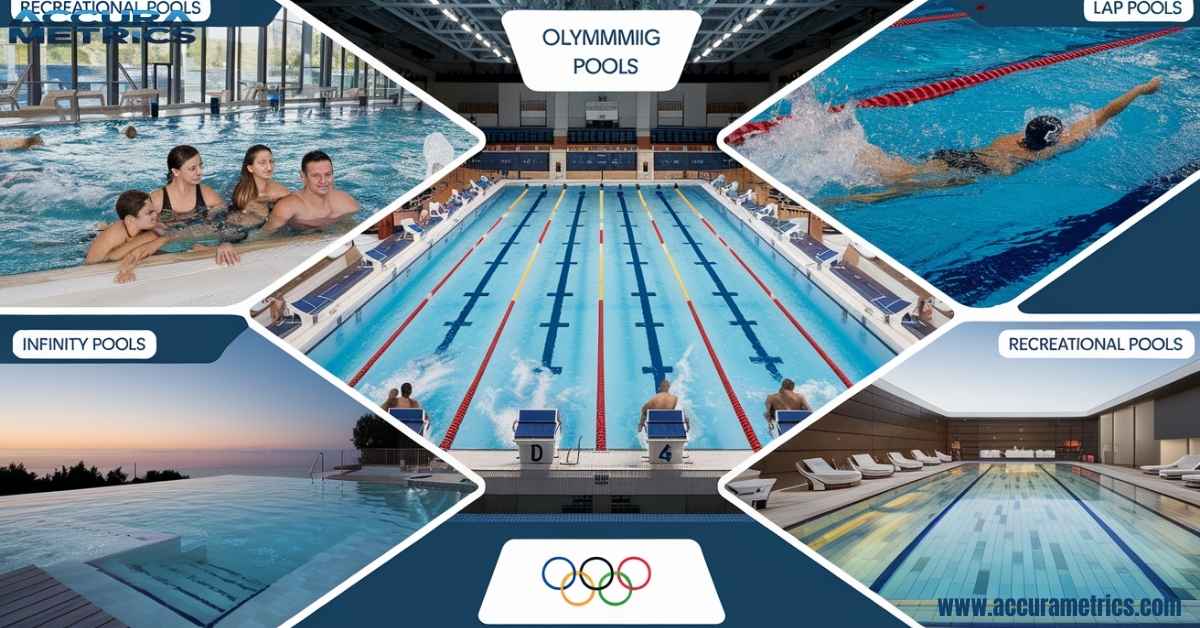When you are planning to install a swimming pool, the size and shape of your pool are two of the most important factors to consider. The pool dimensions you choose can impact everything from functionality to aesthetics, and even the total cost of construction and maintenance.
In this guide, we will dive into the standard swimming pool sizes and explore how various factors influence your choice. Whether you are designing a backyard oasis or a lap pool for fitness, understanding pool sizes is crucial for making the best decision.
Factors Influencing Swimming Pool Size
Choosing the right pool size is not just about picking the largest option that fits into your yard. Several factors should guide your decision to ensure that the pool suits both your space and your needs. Below, we will go over the key considerations.
Available Space
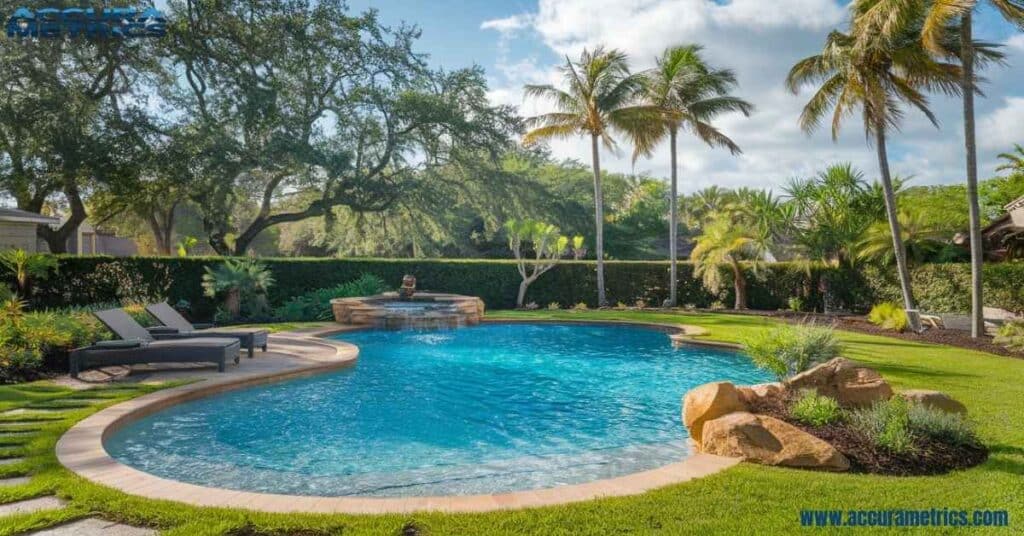
The most obvious factor is the available space in your backyard or designated pool area. Measure the area thoroughly to understand how much room you have for a pool. Do not forget to account for additional space needed for pool equipment, lounging areas, landscaping, and pathways.
Some standard pool sizes work well in smaller yards, while larger pools may be suitable for spacious estates. If your space is limited, consider compact pool options like plunge pools, which offer a swimming experience in a smaller footprint.
Purpose of the swimming Pool
What do you envision using the pool for? Will it be for recreation, exercise, or simply a design feature in your garden? Understanding the purpose will help determine the ideal pool size and shape:
- Recreation: A standard family pool typically falls between 12×24 feet to 15×30 feet.
- Lap swimming: For fitness focused pools, the ideal length is generally 40-50 feet.
- Design feature: For pools that are more about aesthetics, shapes like infinity pools or natural pools may require customization.
Budget Considerations
Your budget is a crucial factor in determining the size of your pool. Larger pools require more materials, more labor, and higher ongoing maintenance costs. Before selecting a pool size, consider the long term costs of:
- Construction (materials, labor)
- Landscaping and decking
- Maintenance (chemicals, cleaning, energy)
If you are working with a limited budget, a smaller pool might make sense, or you could opt for a custom pool design that prioritizes functionality over size.
Local Regulations and Codes
Always check with your local authorities regarding zoning laws and building codes that might affect your pool’s size and installation. Some areas may have restrictions on pool sizes, setbacks from property lines, or safety features like fencing. Ensure you comply with these regulations to avoid costly adjustments.
Standard Swimming Pool Dimensions
Swimming pools come in a variety of shapes and sizes, with certain dimensions becoming more common in different settings. Below are the standard swimming pool dimensions for some of the most popular pool types.
Rectangular swimming Pool
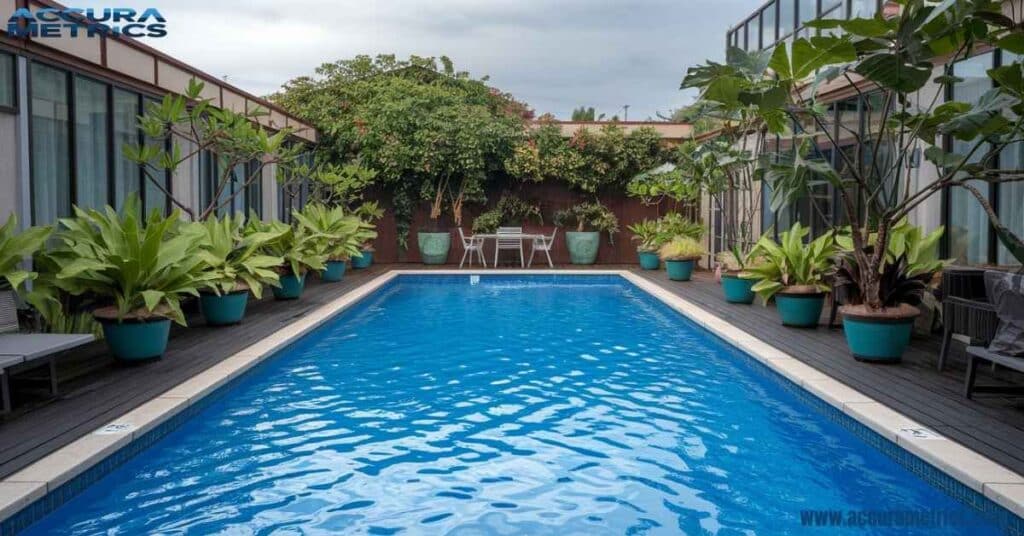
Rectangular pools are the most common type found in both residential and commercial settings. They are often the best choice for those who want a functional pool for swimming and relaxation.
- Typical Lengths: Most rectangular pools range from 25 feet to 50 feet in length, depending on your space and intended use.
- Widths: The width generally ranges between 10 feet and 20 feet.
- Depth: A typical rectangular pool has a depth of 3-5 feet in the shallow end and 6-9 feet in the deep end. However, some pools can be uniformly deep, especially in lap pools.
| Pool Size | Length | Width | Depth (Shallow) | Depth (Deep) |
| Standard | 25 ft | 12 ft | 3 ft | 5 ft |
| Large | 30 ft | 15 ft | 4 ft | 8 ft |
| Olympic | 50 m | 25 m | 2 m | 3.5 m |
Read Amazing About “Joe Rogan House Dimensions: Amazing Facts You Should Know”
Oval and Kidney Shaped Pools
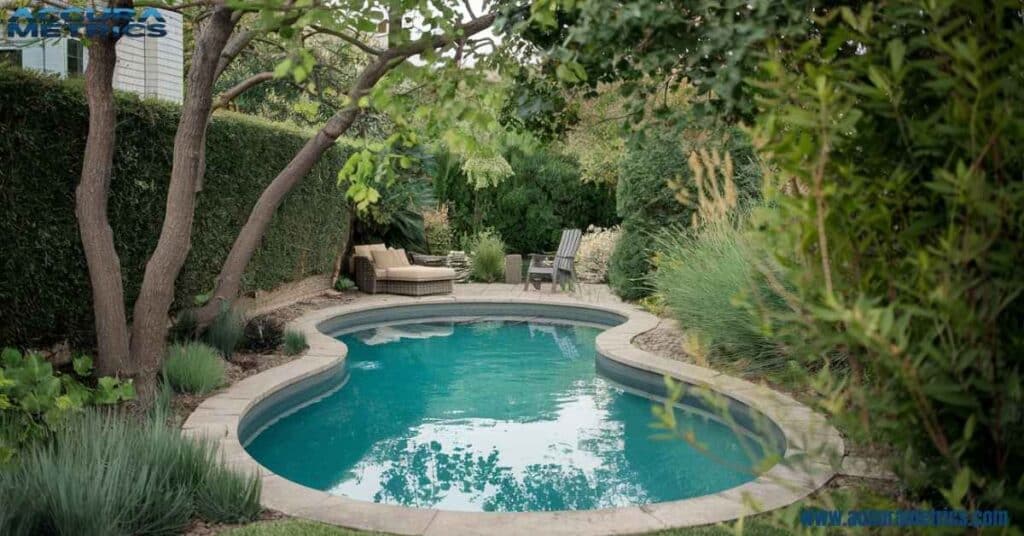
For those looking for something more artistic or space efficient, oval and kidney shaped pools offer a unique design. These pools often suit smaller yards while still providing ample swimming space.
- Sizes: Oval pools can range from 15 feet to 25 feet in length and 10 feet to 15 feet in width.
- Depth: These pools often have a uniform depth of 4 to 5 feet, but some variations may have a shallow end.
Circular and Round Pools
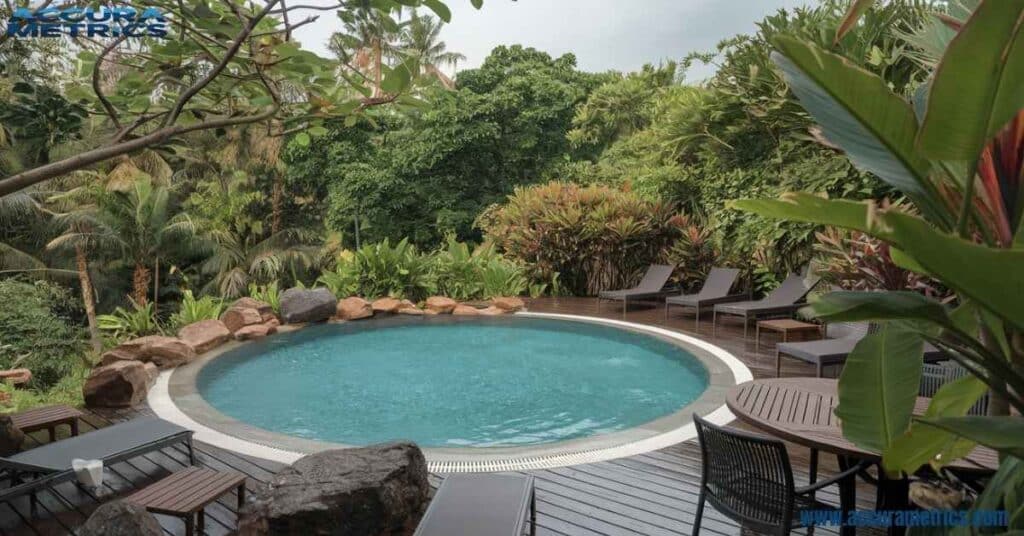
Circular pools are perfect for smaller yards or people who want a distinct, stylish pool. They offer a 360 degree swim experience and are perfect for social gatherings.
- Sizes: Most circular pools range in diameter from 12 feet to 20 feet.
- Depth: These pools often have a uniform depth, usually 4 feet to 5 feet.
Popular swimming Pool dimentions by Usage
Depending on how you plan to use the pool, the ideal dimensions may vary. Let us break it down by the purpose of the pool.
Read Further “Mike Tyson’s Home Dimensions: Size, Space, and Design”
Olympic Pools

Olympic pools are designed for high level swimming competitions, meeting the strict standards set by the International Swimming Federation (FINA). These pools are 50 meters long and 25 meters wide, with multiple lanes to accommodate various events like races and relays.
The depth varies, with 2 meters at the shallow end and up to 3 meters at the deep end, providing enough space for both competitive swimmers and divers. In addition to the spacious lanes, Olympic pools are equipped with designated areas for diving.
These areas are specifically designed to ensure the safety of athletes during dives. The clarity and maintenance of the pool ensure optimal performance for swimmers, making it the ideal environment for breaking records and hosting prestigious competitions.
Fun Fact:
Did you know that the Olympic pool is so large it can hold up to 660,000 gallons of water? That is enough to fill nearly 10 backyard swimming pools. Plus, the water temperature is carefully controlled to ensure the best performance for swimmers usually between 77°F and 82°F (25°C and 28°C). So, next time you dive into an Olympic pool, remember it’s not just big it is built for perfection.
Recreational Pools
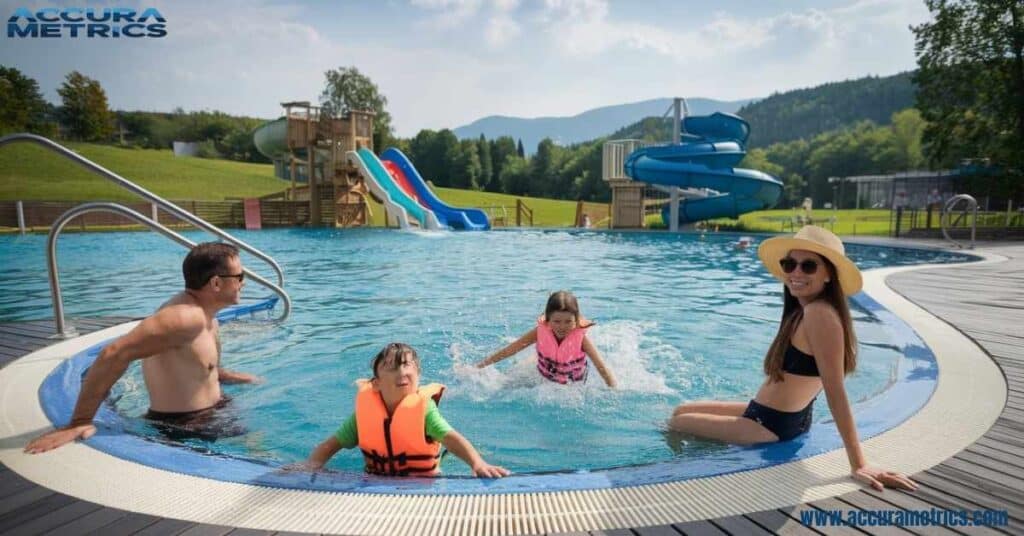
Recreational pools are perfect for family fun, pool parties, and relaxation. They do not need to be excessively large but should offer enough room for swimming and playing.
- Standard Sizes: These pools typically range from 10×20 feet to 15×30 feet.
- Depth: Generally, 3-5 feet is ideal for recreational pools, as it is safe for kids and adults to swim and play in.
Lap Pools
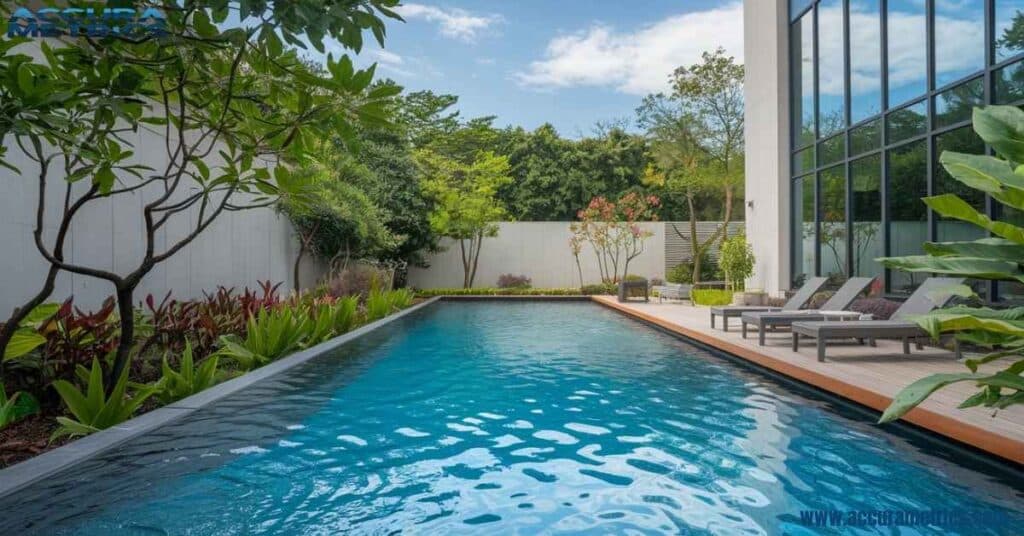
If you are serious about fitness swimming, a lap pool is the way to go. These pools are designed for continuous swimming, often without the distractions of other pool features like slides or diving boards.
- Standard Length: Lap pools are generally between 40 feet and 50 feet long.
- Width: They are typically 8 feet wide, which is enough for comfortable lap swimming.
- Depth: The depth is usually uniform at 4-5 feet or deeper for safety when swimming laps.
Infinity Pools
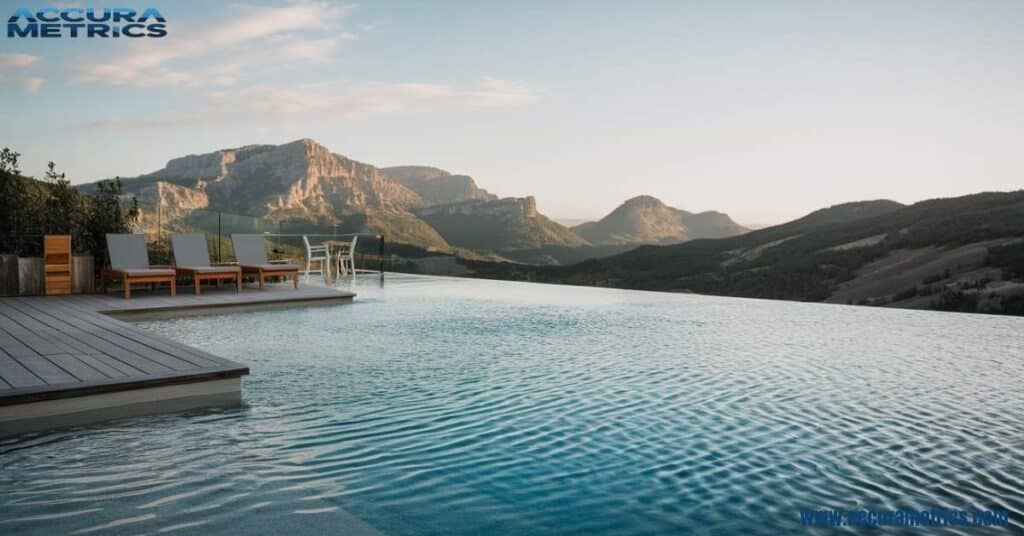
Infinity pools (also called vanishing edge pools) are designed to create the illusion that the pool’s water flows over the edge. They are often used in luxury settings or homes with stunning views.
- Sizes: Infinity pools tend to be longer than typical pools, ranging from 30 feet to 50 feet.
- Design Considerations: These pools often require specialized construction, which can drive up costs. The size depends largely on the landscape and how you want to integrate the pool with the environment.
Read Intrested Fects About “How Many Ounces in a Gallon? Your Easy Measurement Guide”
swimming Pool Size and Shape Customization

Custom pools are becoming more popular as homeowners seek to create pools that match their unique preferences. If a standard rectangular or oval pool does not fit the vision for your yard, custom designs offer the flexibility to suit your space.
Advantages of Custom Pools
- Space Optimization: Custom pools can be designed to fit irregularly shaped yards or specific features like waterfalls, boulders, or hot tubs.
- Functionality: Custom pools can be tailored to include areas for swimming, lounging, or entertaining.
- Aesthetic Appeal: If you are looking for a pool that integrates seamlessly into your landscape, a custom design allows for more creativity.
Challenges of Custom Pools
- Cost: Custom pools often come with a higher price tag due to the complexity of design and installation.
- Time: Custom pool designs take longer to build, requiring more detailed planning and consultation with designers.
- Installation Complexity: Custom pools may require more specialized labor, which can lead to additional costs.
Calculating swimming Pool Volume and Depth
When planning your pool, understanding its volume and depth is essential. Pool volume plays a role in water treatment and chemical balancing. It also affects the energy consumption of pumps and heaters.
Volume Calculation
To calculate the volume of your pool, you can use a simple formula based on the pool shape:
- To calculate the volume of your pool, you can use a simple formula based on the pool shape:
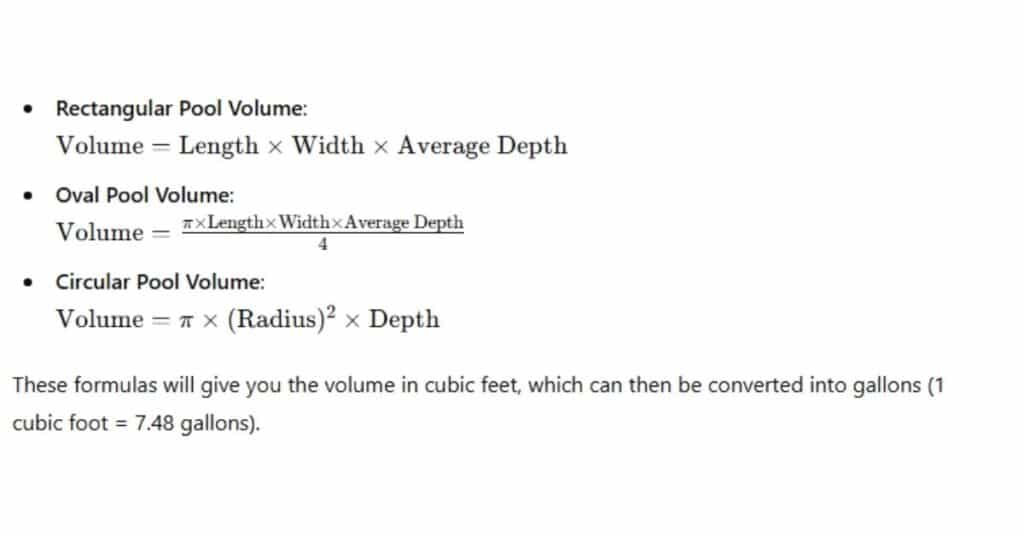
Depth Considerations
The depth of the pool depends on the purpose:
- Shallow pools (3-4 feet) are great for lounging and small children.
- Deep pools (5-9 feet) are ideal for diving and competitive swimming.
Read More “What Is Land Measurement? And How to Measure It”
Maintenance and Cost of swimming Pool
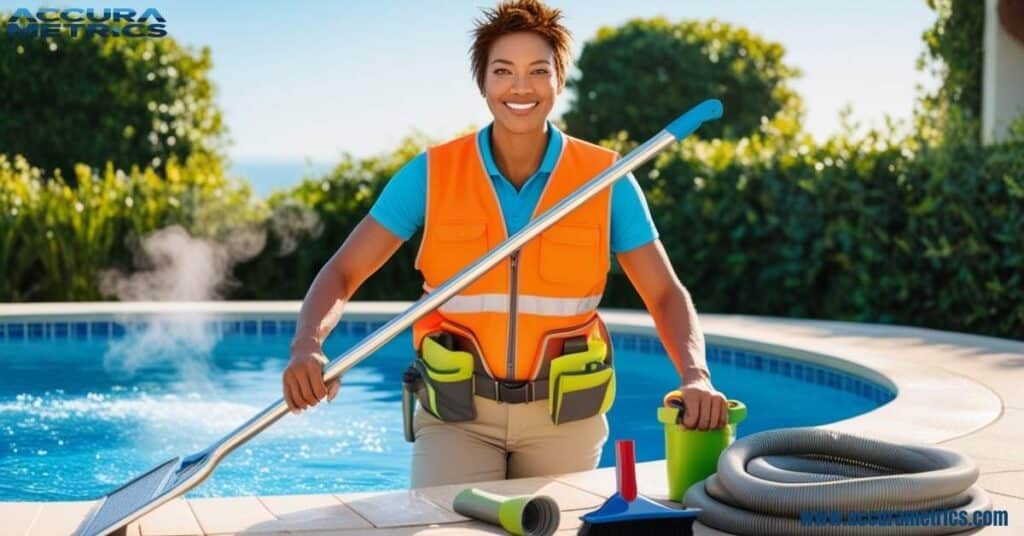
Larger pools come with their share of challenges, including higher maintenance costs and energy consumption. Here is what you need to know:
Larger Pools
- Higher Maintenance Costs: More water means more chemicals and cleaning time. Salt water systems or chlorine needs to be adjusted based on volume.
- Energy Consumption: Larger pools require more powerful pumps and heating systems, leading to higher utility bills.
Smaller Pools
- Less Maintenance: Smaller pools require fewer chemicals and cleaning, making them more cost efficient.
- Energy Efficiency: They are less expensive to heat and filter, saving on energy costs.
| Pool Size | Maintenance Cost (Annually) | Chemical Costs (Annually) | Cleaning Costs (Annually) | Heating Costs (Annually) |
|---|---|---|---|---|
| Small Pool (up to 10,000 gallons) | $500 – $1,000 | $100 – $200 | $150 – $300 | $300 – $500 |
| Medium Pool (10,000 – 20,000 gallons) | $1,000 – $1,500 | $200 – $400 | $300 – $500 | $500 – $1,000 |
| Large Pool (20,000 – 30,000 gallons) | $1,500 – $2,500 | $400 – $600 | $500 – $800 | $1,000 – $1,500 |
| Extra-Large Pool (30,000+ gallons) | $2,500 – $5,000 | $600 – $1,000 | $800 – $1,200 | $1,500 – $2,500 |
Notes:
- Maintenance Costs include regular cleaning, chemical balancing, and equipment upkeep.
- Chemical Costs cover the cost of chlorine, algaecides, pH balancers, and other pool treatment chemicals.
- Cleaning Costs involve pool cleaning services or equipment for skimming, brushing, and vacuuming the pool.
- Heating Costs depend on the size of the pool, heating method (gas, electric, or solar), and local climate.
Read More “Trump Tower Dimensions: New York’s Iconic Landmark”
FAQs About Swimming Pool Dimensions
What is the standard size of a swimming pool?
The standard size of a swimming pool depends on its intended use. For residential pools, a typical size ranges from 12×24 feet to 15 x 30 feet. For Olympic pools, the standard dimensions are 50 meters long, 25 meters wide, and at least 2 meters deep.
What is the recommended size of a pool?
The recommended size of a pool varies based on its purpose. For recreational use, a pool between 12×24 feet and 15×30 feet works well for most backyards. If you plan to use the pool for lap swimming or fitness, a longer pool, typically around 40-50 feet, is ideal.
Is 15×30 a good pool size?
Yes, a 15×30 feet pool is a great size for a residential swimming pool, offering enough space for recreational swimming, pool parties, and lounging. It’s large enough for family use but not too big to overwhelm smaller backyards.
Is a swimming pool 50 m or 150 cm?
The typical length of an Olympic-sized swimming pool is 50 meters (164 feet). However, 150 cm refers to the depth of some pools, with deeper pools used for activities like diving or competitive swimming. These measurements reflect different aspects of pool dimensions.
What is the standard swimming pool size for schools?
For school swimming pools, the standard size often ranges from 25 meters long to 50 meters long, depending on the intended use. Smaller pools may be used for younger children or swim lessons, with dimensions around 12×24 feet, while larger pools can accommodate competitions or group activities.
Conclusion
Understanding standard swimming pool sizes and their variations is critical when planning for a new pool. Whether you are installing a rectangular pool, an oval pool, or a lap pool, it is essential to consider the space available, the intended use, and your budget.
Customizing the size and shape of your pool can further enhance its appeal, but it may also increase costs and complexity. Regardless of the choice, the key is to find a balance between size, functionality, and aesthetics.
By carefully considering your needs and space constraints, you can create the perfect swimming environment that is both enjoyable and practical.
Read details about “North Sea Dimensions: A Complete Overview”

My name is Linda, and I am an experienced blogger with a passion for precision and craftsmanship. With years of expertise, I contribute to Accura Matrics, bringing a wealth of knowledge and a keen eye for detail. My insightful articles and expert tips are designed to help readers achieve excellence in their measurements and dimensions projects, offering valuable guidance in the pursuit of accurate and thoughtful design.

